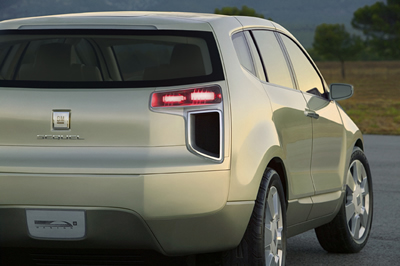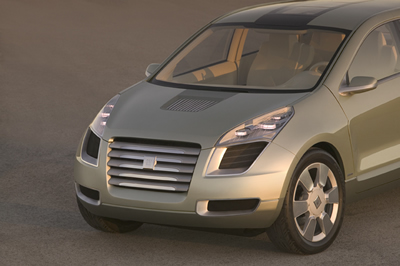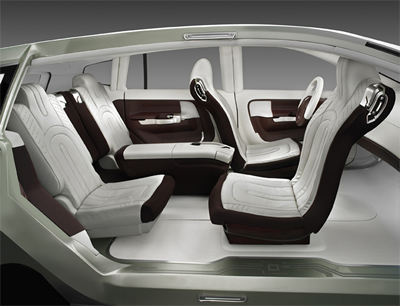|
From AutomotiveArticles.com Auto Shows
DETROIT - Unfamiliar technology can be daunting, but carefully executed design elements in the Sequel combine a number of advanced technologies in a comfortable and inviting package. "The Sequel's design is forward looking, but doesn't allow the underlying technology to overpower the driving experience," said Ed Welburn, GM vice president of design. "From the sleek, clean exterior to the intuitive interior, Sequel reinforces the viability of the technology and connects the user to the technologies in a very comfortable and familiar way."
"The layout of the chassis and fuel cell system required a vehicle with a SUV-like stance," Welburn said. "Contemporary crossover-type vehicles also appeal to drivers because of their combination of car and SUV attributes - attributes definitely woven into the Sequel, such as a flat floor for easier cargo loading." And while hinting of the future, Sequel's seductive design is rooted in conventional driving requirements. That's because the Sequel will undergo a series of real-world driving evaluations in traffic and at highway speeds, meaning designers and engineers had to incorporate production-vehicle criteria into the vehicle's design. The design team made sure the Sequel looked at home on the road. "We designed a realistic vehicle," said Robert Boniface, GM director of advanced design. "The importance of the Sequel is that it's a realistic, driveable and credible vehicle, so its design had to reflect that. It doesn't look like an outlandish, unreal dream machine." A multitude of details tie elements of the exterior and interior together, as if they were parts of a precise, mechanical puzzle. Almost no corners or parting lines meet squarely; rather, they appear to "lock" together. "All the intersecting elements may not be visible or readily apparent, but they work together to tighten the overall look of the vehicle," Boniface said. "As a result, the Sequel looks and feels extremely solid." Global design trends also influenced the Sequel's design, both inside and out. Designers anticipated near-future trends in shapes, colors, lighting and materials by studying everything from Scandinavian furniture to the latest Asian-designed cell phones and sports shoes. Distinct Identity
"We asked the engineers if the vents could be moved," Boniface said, "and, after some careful studies of airflow, we learned the Sequel's thermodynamics actually improved with the vents under the taillights. So that's where we placed them." The front-end styling also has unique headlamps and turn signals. The headlamps are made up of LEDs that magnify light through glass blades. This provides both superior light and a high-tech appearance. Also, the LED lights require less energy and create less heat than conventional headlamps. Their compactness and brightness allowed designers to develop lighting modules that are small enough to accommodate the radiator grilles beneath them. LED lighting carries over to the rear of the vehicle, too, making up the elements of the taillamps. Sequel also has a full-length sunroof comprising separate sections that slide rearward. The windows and sunroof glass are tinted green, which complements the light metallic green exterior color. Interior Integration Sequel's interlocking design theme carries over to the interior. Elements are visibly integrated, from the floor panels to the seats. The vehicle's HVAC system is located under the hood instead of inside the instrument panel. Designers were able to rethink the role and placement of traditional controls. Instead of a center-dash control panel for the climate and audio system controls, individual controls for the driver and front passenger are located on the door armrests. Even the air vents are unconventional. Air wafts out from behind the "floating" instrument panel via a high-volume/low-pressure HVAC system, similar to that of a cabin-pressurized airliner. Other instrument panel features include:
And like the "floating" instrument panel, designers created a multipurpose, movable center console for the Sequel. It "floats" on a special track that moves the console closer to either the front or rear passengers, allowing access to the vehicle's audio/DVD/navigation systems, as well as Bluetooth USB ports and computer docking points. The console also contains a DVD/navigation screen and storage compartments for items such as DVDs or video game controllers. "The center console can be configured to meet many lifestyle needs," said Anne Asensio, GM executive director, advanced design. "It can deliver driver-oriented information, or it can become the hub of a shared conversation space that connects passengers."
The Sequel also features OnStar, the nation's leading provider of in-vehicle safety, security and information services using the Global Positioning System (GPS) satellite network and wireless technologies. Owners can interact with OnStar's voice recognition system in Spanish, French or English. With the push of a button an OnStar advisor can change the system to allow the subscriber to interact with the system in their preferred language. Other core OnStar services are stolen vehicle location assistance, remote door unlock, roadside assistance, emergency services and automatic crash notification. GM is the only automotive manufacturer committed to offering a full range of vehicles with safety protection before, during and after a collision. All OnStar-equipped vehicles come with Automatic Crash Notification. If air bags deploy, the system sends a signal to a highly trained OnStar Emergency Advisor, who contacts the vehicle to see if help is needed, and can contact an emergency responder to send for help. In many cases the occupants are severely injured and cannot speak for themselves. OnStar's GPS unit allows Advisors to tell emergency responders the vehicle's location. OnStar responds to at least one air bag deployment in the US or Canada every hour. Additionally, many 2006 GM vehicles will offer the GM-exclusive Advanced Automatic Crash Notification system. The AACN system detects collisions, even rollovers, regardless of whether air bags deploy. AACN also transmits other crash data, such as the direction of impact force, the number of and which air bags deployed and the maximum change of impact velocity, so that emergency responders are more prepared with this critical information before they arrive at the accident scene. © Copyright 2006 by AutomotiveArticles.com |



